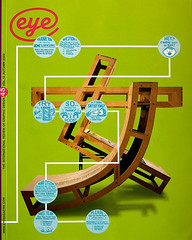Autumn 2002
Typographic footnotes for the future
TypoGraphic Writing
Edited by David Jury<br>ISTD, £15.95This heavy little compendium is a mixed bag. It’s accurately self-described on the cover as ‘Selected writing from thirty years of TypoGraphic, the journal of the International Society of Typographic Designers’ (ISTD). There’s fascinating writing in here, but there’s dross, too, and I can’t help thinking that it’s bound to appeal most to the members of ISTD (more commonly known as STD, the ’I’ having been added fairly recently), who presumably have been reading the pieces as issues of TypoGraphic appear. I come to this from the outside, being in the perhaps unusual position for an Eye reviewer of having never read an issue of TypoGraphic.
The contributors to TypoGraphic have generally been practitioners speaking to other practitioners. Some of them are also writers, but some are not. It would have helped those coming to the book cold if the essays had been more tightly edited, with notes on context and with corrections and updates where needed. Otherwise, too much of the writing becomes of purely historical interest.
David Jury, the editor of TypoGraphic since 1996 (except for one issue edited by Freda Sack), is credited as both editor and designer of this book, so presumably it reflects his vision and his choices, both of material and of how to present it. The 300-plus pages of essays are presented in a Modernist format that I’ve often seen used (and used myself) to good effect: a narrow, left-hand column for small illustrations, captions and the occasional note, and a wider, right-hand column for the text, set unjustified. Larger illustrations either fit into the text column or spread across both. Here, however, while it all looks clean and minimalist, it doesn’t actually read well. The text is set in a very small size of Foundry Form Serif, in very long lines – not a comfortable format for extended reading.
The selections are organised in four categories: ‘Working practice’ (30 essays), ‘Technology’ (14), ‘Education’ (12), and ‘History’ (6), plus an index to the book and a separate index to all the articles in TypoGraphic 1971-2001. The running heads state only the book title and the section title, leaving a browsing reader to guess which essay and which writer a given page spread belongs to. The book suffers from some proof-reading glitches, including random insertion of commas and occasional dropped words and the potentially useful index appears not to have been proof-read at all, or at least not by the same person who proofed the rest of the book. These are not gratuitous gripes; the problems with the book’s format and its execution make the difference between it being a usable reference work or being simply stored on a shelf.
But it must have been fun selecting the articles. The write-up of Letraset’s type design competition in 1973 reminds us what the type world looked like 30 years back, not only through the sober facts but through an astonishing page of (winning!) typeface entries, such as Suds and Good Vibrations, and a blurry photograph of the panel of judges, some of them looking eerily of-the-moment. Less frivolously dated articles include Vincent Steer’s reminiscence of the founding of the STD (originally the British Typographers Guild) in the 1920s and Maurice Goldring’s 1971 proposal for a ‘Standard Specification System for Print.’ (The latter could have benefited from an editorial update on the state of print specification today.)
The best pieces are the ones that present forceful ideas. F. H. K. Henrion (1973) quotes Nicolete Gray’s useful distinction between ‘public and private reading matter’, and later Fred Smeijers writes (1999) on the closely related question of ‘typography versus commercial lettering’. David Kindersley’s 1983 explanation of his system for automatically letterspacing display type mostly reminds me of why it’s so nearly impossible to automate this task, but I’m glad to have his discussion reprinted here. Peter Rea’s extracts from talks with Derek Birdsall (1978) about book design are highly useful, despite the moiré patterns in the twice halftoned images. Birdsall’s notes on the interaction of designer and production team are timeless. Alas, so are Don Rooum’s cogent remarks (1982) on students who don’t read: ‘A typographic designer needs a lively interest in written communication.’
Colin Banks’s clear account of redesigning the telephone directory for British Telecom in 1980 pairs nicely with George Sadek’s detailed description of the creation of Bell Centennial in the 1970s for the more varied American phone books (although the captions in the latter essay refer to shades of grey that do not show up in the reproduced images of superimposed letters).
Conspicuously missing from the book’s ancillary material is any writers’ biographical information. Wim Crouwel says in his introduction, ‘What is written about our discipline today is research material tomorrow.’ This book could have been more than just a source of future footnotes.
John D. Berry, designer, San Fransisco
First published in Eye no. 45 vol. 12, 2002
Eye is the world’s most beautiful and collectable graphic design journal, published quarterly for professional designers, students and anyone interested in critical, informed writing about graphic design and visual culture. It is available from all good design bookshops and online at the Eye shop, where you can buy subscriptions and single issues.

